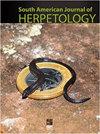胸膜瘤的形态计量学变异(无尾目:瘦偶蹄目:鳞翅目):化石性的证据?
IF 0.7
4区 生物学
Q4 ZOOLOGY
引用次数: 1
摘要
摘要栖息在干燥栖息地的Anurans表现出特殊的生活史,并具有与挖洞行为相关的形态特征(例如,特殊的跖骨结节、相对于体型的短后肢)。新热带Pleurodema属包括15种,主要分布在干旱和半干旱环境中。该属记录了向后挖洞的行为,以及特殊的内跖骨结节的存在。然而,与挖洞相关的形态计量学变化在胸膜瘤中尚未得到充分研究。为了探索这种变化,我们对代表14种胸膜瘤的615个成年标本的13个外部身体测量值进行了评分,并检查了跖骨结节的形态。我们还总结了该属所有物种的卵囊结构、孵化时间和幼虫期持续时间的现有数据。我们的研究结果表明,体型变化主要由后肢元素相对长度的差异组成。短胸胸肌、双孢胸肌、瓜亚帕胸肌、星云胸肌、tucumanum胸肌和马齿胸肌的后肢元件相对于吻部-出口长度最短,除马齿胸衣外,其他胸肌都有角化的内跖骨结节。从生物力学角度来看,这些特征的结合被认为是化石的专门化。短胸胸脯肉、双孢胸脯肉属、瓜亚帕伊胸脯肉和tucumanum胸脯肉的孵化时间和幼虫期也最短。幼虫期短与无尾肢伸长期的停滞有关。掘穴性能和发育效应都可以解释胸膜虫肢体形态的变化。本文章由计算机程序翻译,如有差异,请以英文原文为准。
Morphometric Variation in Pleurodema (Anura: Leptodactylidae: Leiuperinae): Evidence of Fossoriality?
Abstract. Anurans that inhabit dry habitats exhibit particular life histories and possess morphological features associated with burrowing behavior (e.g., specialized metatarsal tubercles, short hind limbs relative to body size). The Neotropical genus Pleurodema includes 15 species distributed mainly in arid and semiarid environments. Backward burrowing behavior has been recorded in the genus, as well as the presence of specialized inner metatarsal tubercles. However, morphometric variation associated with burrowing has not been sufficiently studied in Pleurodema. To explore this variation, we scored 13 external body measurements and examined the morphology of the metatarsal tubercles of 615 adult specimens representing 14 species of Pleurodema. We also summarized available data about egg-clutch structure, hatching time, and duration of larval period of all species of the genus. Our results revealed that body shape variation mainly consists of differences in the relative length of the hind-limb elements. Pleurodema brachyops, P. diplolister, P. guayapae, P. nebulosum, P. tucumanum, and P. marmoratum have the shortest hind-limb elements relative to snout–vent length, and all but P. marmoratum also have keratinized inner metatarsal tubercles. The combination of these features has been considered a fossorial specialization on biomechanical grounds. Pleurodema brachyops, P. diplolister, P. guayapae, P. nebulosum, and P. tucumanum also have the shortest hatching time and larval period. A short larval period has been related to arrestment in the elongation phase of anuran limbs. Both burrowing performance and developmental effects could explain the variation in the limb morphology within Pleurodema.
求助全文
通过发布文献求助,成功后即可免费获取论文全文。
去求助
来源期刊
CiteScore
1.50
自引率
0.00%
发文量
10
期刊介绍:
The South American Journal of Herpetology (SAJH) is an international journal published by the Brazilian Society of Herpetology that aims to provide an effective medium of communication for the international herpetological community. SAJH publishes peer-reviewed original contributions on all subjects related to the biology of amphibians and reptiles, including descriptive, comparative, inferential, and experimental studies and taxa from anywhere in the world, as well as theoretical studies that explore principles and methods.

 求助内容:
求助内容: 应助结果提醒方式:
应助结果提醒方式:


